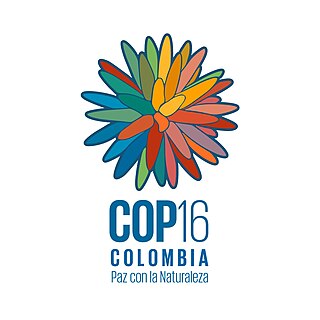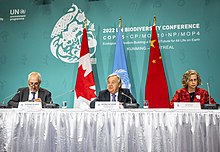
The Convention on Biological Diversity (CBD), known informally as the Biodiversity Convention, is a multilateral treaty. The Convention has three main goals: the conservation of biological diversity ; the sustainable use of its components; and the fair and equitable sharing of benefits arising from genetic resources. Its objective is to develop national strategies for the conservation and sustainable use of biological diversity, and it is often seen as the key document regarding sustainable development.

Biodiversity is the variability of life on Earth. It can be measured on various levels. There is for example genetic variability, species diversity, ecosystem diversity and phylogenetic diversity. Diversity is not distributed evenly on Earth. It is greater in the tropics as a result of the warm climate and high primary productivity in the region near the equator. Tropical forest ecosystems cover less than one-fifth of Earth's terrestrial area and contain about 50% of the world's species. There are latitudinal gradients in species diversity for both marine and terrestrial taxa.

Protected areas or conservation areas are locations which receive protection because of their recognized natural or cultural values. Protected areas are those areas in which human presence or the exploitation of natural resources is limited.
Rio Convention relates to the following three conventions, which were agreed at the Earth Summit held in Rio de Janeiro in June 1992.

The Living Planet Index (LPI) is an indicator of the state of global biological diversity, based on trends in vertebrate populations of species from around the world. The Zoological Society of London (ZSL) manages the index in cooperation with the World Wide Fund for Nature (WWF).

The Biodiversity Indicators Partnership (BIP) brings together a host of international organizations working on indicator development, to provide the best available information on biodiversity trends to the global community. The Partnership was initially established to help monitor progress towards the Convention on Biological Diversity (CBD) 2010 Biodiversity target. However, since its establishment in 2006 the BIP has developed a strong identity not only within the CBD but with other Multilateral Environmental Agreements (MEAs), national and regional governments and other sectors. As a result, the Partnership will continue through international collaboration and cooperation to provide biodiversity indicator information and trends into the future.
Environmental governance (EG) consists of a system of laws, norms, rules, policies and practices that dictate how the board members of an environment related regulatory body should manage and oversee the affairs of any environment related regulatory body which is responsible for ensuring sustainability (sustainable development) and manage all human activities—political, social and economic. Environmental governance includes government, business and civil society, and emphasizes whole system management. To capture this diverse range of elements, environmental governance often employs alternative systems of governance, for example watershed-based management.
The United Nations General Assembly had declared 2011–20 the United Nations Decade on Biodiversity. The UN Decade on Biodiversity had served to support and promote implementation of the Strategic Plan for Biodiversity and the Aichi Biodiversity Targets, with the goal of significantly reducing biodiversity loss. None of the 20 aichi targets were achieved, though progress was made towards several of them.
Kerala State Biodiversity Board (KSBB)

Biodiversity loss happens when plant or animal species disappear completely from Earth (extinction) or when there is a decrease or disappearance of species in a specific area. Biodiversity loss means that there is a reduction in biological diversity in a given area. The decrease can be temporary or permanent. It is temporary if the damage that led to the loss is reversible in time, for example through ecological restoration. If this is not possible, then the decrease is permanent. The cause of most of the biodiversity loss is, generally speaking, human activities that push the planetary boundaries too far. These activities include habitat destruction and land use intensification. Further problem areas are air and water pollution, over-exploitation, invasive species and climate change.
Ecosystem-based adaptation encompasses a broad set of approaches to adapt to climate change. They all involve the management of ecosystems and their services to reduce the vulnerability of human communities to the impacts of climate change. The Convention on Biological Diversity (CBD) defines EBA as "the use of biodiversity and ecosystem services as part of an overall adaptation strategy to help people to adapt to the adverse effects of climate change".

30 by 30 is a worldwide initiative for governments to designate 30% of Earth's land and ocean area as protected areas by 2030. The target was proposed by a 2019 article in Science Advances, "A Global Deal for Nature: Guiding principles, milestones, and targets", highlighting the need for expanded nature conservation efforts to mitigate climate change. Launched by the High Ambition Coalition for Nature and People in 2020, more than 50 nations had agreed to the initiative by January 2021, which has increased to more than 100 countries by October 2022.
Digital sequence information (DSI) is a placeholder term used in international policy fora, particularly the Convention on Biological Diversity (CBD), to refer to data derived from dematerialized genetic resources (GR).

The 2022 United Nations Biodiversity Conference of the Parties (COP15) to the UN Convention on Biological Diversity (CBD) was a conference held in Montreal, Canada, which led to the international agreement to protect 30% of land and oceans by 2030 and the adoption of the Kunming-Montreal Global Biodiversity Framework.
Other effective area-based conservation measures (OECMs) are sites outside of protected areas that are governed and managed in ways that deliver the long-term in situ conservation of biodiversity. As of March 2023, 856 such sites have been reported to the World Database on Other Effective Area-based Conservation Measures, managed by the UN Environment Programme World Conservation Monitoring Centre. OECMs cover 1,992,729 km2 (769,397 sq mi) of the Earth's surface, accounting for 1,589,090 km2 (613,550 sq mi) on land and 403,639 km2 (155,846 sq mi) in the ocean.

María Susana Muhamad González is a Colombian political scientist, environmentalist and politician belonging to the Humane Colombia party. Since August 7, 2022, she has held the position of Minister of Environment and Sustainable Development in the government of Gustavo Petro. She has called for phasing out fossil fuels including coal, which Colombia exports.

The 2024 United Nations Biodiversity Conference of the Parties (COP16) to the UN Convention on Biological Diversity (CBD) was a conference that was held from October 21 to November 1, 2024 in Cali, Colombia. The monitoring framework agreed at the previous conference should allow the progress of the countries towards national goals and targets under the Kunming-Montreal Global Biodiversity Framework to be evaluated.
A Biodiversity Impact Credit (BIC) is a transferable biodiversity credit designed to reduce global species extinction risk. The underlying BIC metric, developed by academics working at Queen Mary University of London and Bar-Ilan University, is given by a simple formula that quantifies the positive and negative effects that interventions in nature have on the mean long-term survival probability of species. In particular, an organisation's global footprint in terms of BICs can be computed from PDF-based biodiversity footprints. The metric is broadly applicable across taxa and ecosystems. Organisations whose overall biodiversity impact is positive in terms of the BIC metric contribute to achieving the objective of the Global Biodiversity Framework to "significantly reduce extinction risk".
Nature-positive is a concept and goal to halt and reverse nature loss by 2030, and to achieve full nature recovery by 2050. According to the World Wide Fund for Nature, the aim is to achieve this through "measurable gains in the health, abundance, diversity, and resilience of species, ecosystems, and natural processes." Progress towards this goal is generally measured from a biodiversity baseline of 2020 levels.











